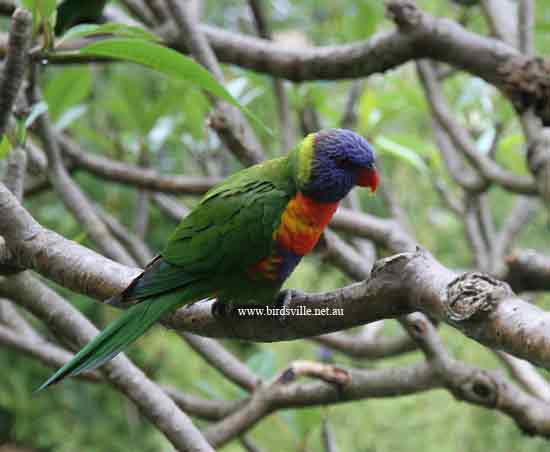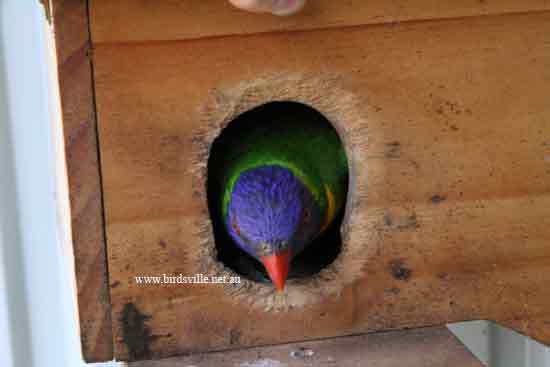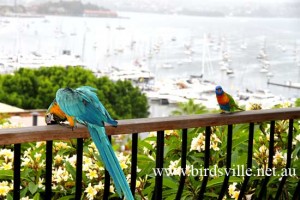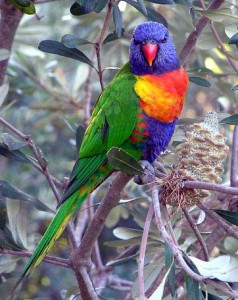Pet Rainbow Lorikeet for Information

Distribution of Rainbow Lorikeets
Rainbow Lorikeets are found in Australian mainly in northern and eastern areas. Their habitat are wet sclerophyll forest, rainforest, coastal forests, suburbs and urban areas with trees. They can also be found in Indonesia, Vanuatu and New Caledonia. They have been introduced into Perth and a well establish population has occur.
In the last twenty years Rainbow Lorikeets have become more common in major city around Australia, including Sydney, Melbourne and Brisbane.
Weight
125-150 grams
Length
around 14 inches

Description and Sexing Rainbow Lorikeet’s
Rainbow Lorikeet truely live up to their name, with bright plumage and a personality to match. They have a violet blue head, light green strip at the back of the neck, green back wings and tail, with yellowy/red/orange chest. The chest colouration of many bird varies in colour. this is no idication of sex, as the males and females look identical, the only way to sex these birds is DNA and sergical sexing.
Juvinile bird have duller plumage then the adult, brown eye instead of black and a black beak instead of bright red/orange. It can take up to a year before juviniles fully colour up and get their bright colours.

Care and Feeding Lorikeet’s
Rainbow lorikeets unlike most parrots don’t eat seed, in the wild lorikeets feed on nectar and pollen from plants and flowers. Pet lorikeets require a nectar replacement diet, which are available at Birdsville. These mixes come in powder form and there are two main types of nectar replacemet, eware of some supermarket lorikeet feeds as they are low quality some very healthy lorikeet foods include vetafarm forest fusion, wombaroo, and golden lory rice formula.
Good quality Dry mix (Lorri-dry) – with dry, plenty of fresh drinking water needs to be made available for the bird.
Good Quality Wet mix (Lorri-wet) – with wet, their requirements for drinking will be reduced, as the feed contains a large amount of water, however fresh drinking water should still be made available.
Young birds should be feed on both wet and dry mix in separate containers and can later be weaned on to dry mix only.
If you unsure Of the Quality of the Lorikeet Mix you feed your bird ask your local bird Expert.
Rainbow lorikeets also need their diet supplemented with fresh fruit and vegetables on a daily basis. Spinach or silverbeet leaves are important to provide calcium for the bird. Your bird with also require vitamin mixed into their water every two to three days. This is to provide essential nutrients commonly deficient in their diet. Also supply your lorikeet with a calcium supplement.
Do not feed your bird (or any other bird) avocado, onion, chocolate, caffeine or alcohol.
Housing – Cage’s
Rainbow Lorikeets are an active, playful bird that needs suficient room to move around, stretch their wing and play with toys. When choosing a cage keep this in mind and remember the bigger the cage the better off the bird will be.
Select toys that can be chewed, wrestled and played with. Toys with rope, leather, bells and wood. Swing are also important to keep their legs strong and is a form of exercise. Different size perches are important for the bird feet and natural wood is the best.

Introducing your new bird to existing birds
Once you take your bird home you should keep it in a separate cage and allow the bird to adjust accordingly. Let the birds see and listen to each other through their cages to get used to each other. Always allow at least 2 weeks before introducing the bird to an existing bird.
Worming– Have you wormed your bird?
Your bird will need to be wormed in a few weeks to two months after being taken home (check with the staff from Birdsville, when purchasing). Young birds that have been recently weaned have a delicate bacteria’s developing in their gut, worming at this stage could harm the bacteria’s development and your new bird. Worming will need to be done.
every 6 months. Worming your bird is essential for the health of all parrots in captivity.
Lice & Mites
These are the two most common parasites of cage birds and their environment but are easily controlled with a Mite and Lice spray, available at Birdsville. When using spray, spray bird, entire cage, perches, nesting box and toys, remember to remove all water and feed and avoid spraying in birds’ eyes. Your bird Lice and mite bottle will explain how to use, remember avoiding the mouth and eyes.
Enrichment for Lorikeet’s – Toys
Toys are used as a form of environmental enrichment, but enrichment shouldn’t stop there. As an ex-zookeeper it was a major concern that all animals must have a variety environmental enrichment to keep the critters entertained. This is in no way different for anyone who has a tame parrot at home. Enrichment is important because parrots simply cannot thrive with only perches, food and water. The fact is birds provided with enrichment are unlikely to developed psychological problems such as self-mutilation, feather plucking and excessive squawking. Enrichment WILL in fact effect your bird in a positive way with its mental and physical development when training your bird you will actually end up with a better, less fearful, friendlier and relaxed bird which will be more easily trained. Enrichment can be chew toys, play toys, leather toys, acrylic plastic toys, wooden toys, shredding toys, ropes, swings, ladders, bells, balls, birdie balls, plain card board, small boxes, wicker baskets, tray of wheat grass, plants, bird baths, different foods, food kabobs, nuts, (all available at birdsville) You may also find in your local area pine cones, hide food inside pine cones, twigs, bendy branches, flowers and branches- safe flowers are bottle brush, grevilia, eucalypt melaleuca flowers, hibiscus, marigolds, dandy lions leaves and all, roses, violets to name a few.
Note anything found outside should be disinfected and nonpoisonous and toys must be nontoxic.
Enrichment tip- the trick to keeping them entertained is regularly rotating toys as they will become bored with the same toy in their cage day after day. Changing them regularly will create interest for your bird as if they are receiving a whole new toy to play with.

Training Your Bird
Training is an important factor of having a well-behaved hand raised bird. When you first get the bird home, let it settle down and get use to their new environment for a day or two. After these initial days, the bird should be handled in a quiet, relaxed situation. Spending time with your bird while watching TV or reading is perfect, but don’t over stress your bird in the first few weeks of taking it home, babies need their rest. The more time you spend with your bird, the better your bird will become.
When doing any training there are three basic concepts to keep in mind.
- When the bird does something good –> give it a reward.
- When the bird does something undesirable –> ignore it.
- Never punish your bird
Start training your bird with a simple command, like step up.
Have the bird on one hand, place the other hand against the birds’ chest and say the command, step up, as you apply a slight pressure to the birds’ chest. The bird will then put one leg up, pull slightly up with the second hand and the other leg will follow, reward your bird with a treat, like a favorite fruit, seed or nut. Then repeat, as the bird gets better, get it to step up a few times before rewarding. Once your bird catches on to it, instead of rewarding it with food, reward it with praise. This will soon become second nature to the bird.
It is important not to overdo the training, keep it short, but frequent.
What to Look for When Purchasing a Rainbow Lorikeet
Never purchase a bird without having a good look at them first!
When you are ready to purchase your new Little Lorikeet, here are so few hints for what to look for.
- Eyes – should be bright and clear, there should be no discharge, swelling or redness. If the eyes that are runny, squinty, or discolored can be an indication of infection.
- Condition- This is very important and should be understood by any bird owner as a bird handler every time i touch any bird i feel the bird’s condition by touching the birds keel bone which is underneath the bird this is the anchor where the birds large wing muscles attach to allow the bird to have strong wing muscles for flight. When a bird is unwell the first thing that usually happens is they lose weight, and their breast muscle becomes very light on. Because of birds very high metabolic rate they can lose weight very quickly and become ill so this should be checked by bird owners on a regular basis especially if they see there bird not as active as normal.
- Mouth and beak – should be clean and free of injury, no lesion, wetness or build up inside the mouth. The beak should not be overgrown.
- Nose, nostrils or cere – should be open and free of discharge.
- Feathers – the bird should be fully feathered and sleek with a smooth appearance. Depending on the age, often the body and tail feathers will be somewhat ragged due to young birds regularly walking through there wet food and having them rub on objects and wire.
- Wing Clipping – if wings are clipped, both wings should be clipped, not just one and all outer feathers should be cut. If the last two outer feathers are not cut the bird could injure themself and if only one wing is only clipped the bird still may fly, just lopsided and cause injury when landing. Birdsville will clip wing for free with any purchase.
- Weaning – it is highly recommended, if you don’t have hand raising experience, only weaned birds should be bought. Hand feed might look and seem like a simple process, but it can be easily done incorrectly and time consuming. Mistakes when hand feeding can cause irreversible harm and even lead to death of the young bird. Alway choose birds that are fully weaned and eating independently. Your bond with the bird will not suffer for it in the least.
- Voracious eaters – observe the birds that you’re interested in, and you should look for birds that are the most voracious eaters. Choose a bird that displays a large appetite. This is an indication of good general health and well being.
- Dirty vent (anus) – there should be no staining or fecal matter on the feathers around the vent.
- Leg – should look clean.
- Clean enclosure – the enclosure where the birds are kept should be clean and hygienic, to reduce the likeliness of illness or infection.
- Active and alert – The bird should be active and alert. If it appears sluggish or weak it could be ill or too young to be feeding on its own.
Species Specific Problems and how to avoid them
- Yeast infections – Can be caused by of the high sugar content.
Signs to look out for: Your lorikeet is uncharacteristically lethargic and not his normal energetic self.
If Your lorikeet is not behaving normally seek vet advise as soon as possible.
- Fungal infections – Is a common illness in lorikeets and can be caused by a number of reasons. Most commonly it is from poor housing or contaminated food. A lack of vitamin A in their diet can cause the bird to pick up something they shouldn’t.
To minimize the possibility of contacting a fungal infection, keeping them in a clean environment, by regularly cleaning their cage, providing fresh food that is rich in vitamin A, such as carrots and sweet potato and make sure the water is fresh and clean.
- Bacterial infections- Birds can become ill from a variety of bacterial infections found in a home environment which can be contracted from the floor, kids and other animals. Stress can be a large contributing factor making them more prone to sickness.
If your bird is not as active as normal and appears fluffed, immediately upkeep it warm with a heat lamp or a heater close to the cage. Broad-spectrum antibiotic powder is available at Birdsville, which goes into the water or contact a vet immediately.
- Beak and feather disease – Better known as BPFD virus or BPFDV is infectious to all parrots and is usually spread by feather dust and droppings. This is why the virus has become to common and prevalent all over the world and Australia.
Many young birds that have beak and feather disease die at a very early age before they leave the nest. Others show many symptoms from a very young age. These symptoms are often losing feathers but many lorikeets after a while build up an immune response and in time will grow there feathers back as if they never had the virus at all and live a long healthy life. These birds are generally immune from the disease, but probably become carriers for the remainder of there lifetime.
Some birds which have a weak immune system that contract the disease can become ill and eventually die.
There is no vaccine to beak and feather disease, but you can increase the odds for your living a long and happy life by giving your bird a healthy diet, clean environment and eliminating stress.
Which brings us to our next important point.
- Stress- When I was a zookeeper one of our most important jobs was to eliminate stress, as this can be the one of the biggest issues with any animals kept in a captive environment. Eliminating stress is as simple giving your Little Lorikeet the correct environment they need. When they are adults, they love noise and attention, but for young baby birds, in a new home, you do not want to over stress them. Often over excited kids can stress a bird out with too much love and grabbing, chasing etc. Give them time to get used to their new environment to feed and drink and rest. Birds that are stressed are more susceptible to viruses and infections named above.
- Obesity- Obesity is an issue for many captive birds and can result in early death. It is important to having a large cage with swings and different size perches. It is also important for them to have some time to exercise out of the cage, this will help your bird burn some calories. Another major fact is diet, your bird should have a healthy diet with plenty of fresh fruit. There are low fat lorikeet food options available at Birdsville.
- Trauma and injuries- Broken leg, beak, wing and feet. As with any small bird’s damage and injury can occur by simply letting your bird out of a cage and he flies into a window or another common injury in household pets is them flying into a ceiling fan. To avoid this with unclipped birds, you will have to let your bird become use to their new environment making sure all windows are shut, ceiling fans turned off and your bird is supervised while out of the cage. If any of your birds receive any traumatic injuries, you should take your bird to the vet immediately.
Household dangers for hand raised birds.
- Dogs and cats – if not socialized properly can be a big danger for prey animals such as birds. Little Lorikeets must be supervised at all times with a dog or cat in the house. This may be difficult with hunting breeds of dogs and some cats. The resident animals must have some time to get used to the new family member and accept them as a member of the family. I cannot stress enough please be very careful in introducing any new animal as they can be very unpredictable.
- Ceiling fans – Owners of birds can easily forget to turn off ceiling fans when they let the birds out of the cage for a fly which can have disastrous results.
- Windows, doors and mirror
- Poisons – Inhaling or eating toxic substances such as zinc, copper, bleach, oven cleaner, glues, nail polish remover, paint and insecticides to name a few.
- Open water – if a bird falls into a sink full of water or even headfirst into a coffee mug can drown a bird.
- Electric cords
- Inappropriate foods – such as alcohol, chocolate, onion and avocado.
- Drafts – Can be one of the biggest killers of birds causing them to become sick, so keep your feathered friend in a draft free zone.
- Infections – picked up in an unclean house.



